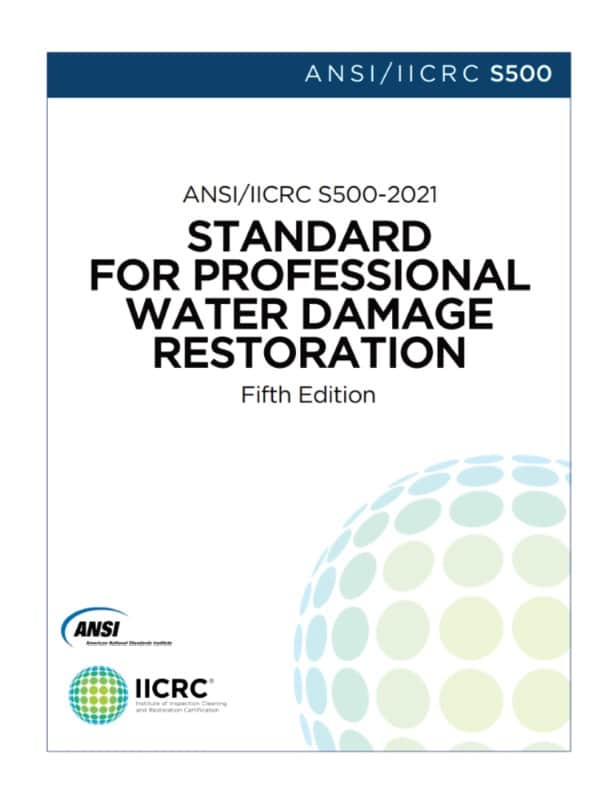What Is the ANSI/IICRC S500 Standard?
A Complete Guide for Homeowners, Property Managers & Insurers
When water damage strikes, the difference between a quick cleanup and a costly structural disaster often comes down to following the right standard.
The ANSI/IICRC S500 Standard for Professional Water Damage Restoration is the globally recognised benchmark that guides the entire drying and restoration process—from the first emergency call to final moisture verification.
Whether you’re a homeowner, property manager, or insurance assessor, understanding the S500 helps you protect your property, health, and financial interests.
What Is the ANSI/IICRC S500 Standard?
The Institute of Inspection, Cleaning and Restoration Certification (IICRC) is an international body that develops science-based standards for cleaning and restoration professionals.
Its S500 document, first published more than two decades ago and updated regularly, sets out the principles, procedures, and best practices required to return water-damaged structures to a clean, dry, and safe condition.
The S500 is more than a technical manual—it is the consensus of scientists, engineers, restoration contractors, and insurance professionals.
By following its guidelines, certified technicians can ensure every job is performed to a defensible, verifiable standard, giving property owners confidence and insurers the documentation they need.
Key Principles of the S500 Standard
The S500 provides a detailed framework for assessing water damage, choosing the right equipment, and documenting every stage of the drying process.
Three key pillars are especially relevant to property owners:
1. Categories of Water Damage
Water intrusions are classified by contamination level, which dictates the cleaning and safety measures required:
| Category | Description | Examples |
|---|---|---|
| Category 1 – Clean Water | Water from a sanitary source that poses no significant risk if dealt with promptly. | Burst potable-water pipe, rainwater that hasn’t contacted soil. |
| Category 2 – Grey Water | Contains significant contamination that could cause illness or discomfort. | Dishwasher or washing machine discharge, aquariums, toilet bowl with urine only. |
| Category 3 – Black Water | Grossly contaminated water with pathogens or hazardous materials. | Sewage backflow, floodwater from rivers or storm surges. |
Why it matters:
A Category 1 incident can quickly degrade to Category 2 or 3 if not addressed within 24–48 hours.
2. Classes of Water Intrusion
Classes describe how much water has evaporated into the environment and how deeply materials are saturated.
They range from Class 1 (small area, minimal absorption) to Class 4 (hard-to-dry materials such as hardwood or plaster).
Technicians use these classes to calculate drying times and equipment needs—ensuring that hidden moisture is removed from subfloors, wall cavities, and structural components.
3. The Drying Process
The S500 outlines a four-stage drying protocol:
- Extraction – Rapid removal of standing water using professional extraction equipment.
- Evaporation – Deployment of air movers to lift moisture from surfaces.
- Dehumidification – Use of dehumidifiers to capture airborne water vapour.
- Monitoring & Verification – Daily moisture measurements until all materials reach dry-standard levels.
This process is underpinned by psychrometry—the science of controlling temperature, humidity, and airflow to accelerate evaporation and prevent mould growth.
Why S500 Compliance Protects You
For Homeowners & Tenants
- Reduces risk of mould, odour, and structural decay.
- Provides documented proof of professional restoration—critical for insurance claims and property resale.
For Property Managers & Insurers
- Ensures jobs are performed to a recognised industry benchmark.
- Reduces disputes and liability by providing clear moisture reports and drying logs.
Hiring a company that ignores these standards can result in hidden moisture pockets, leading to secondary damage, costly litigation, and denied insurance claims.
How Reztor Applies the S500 Standard
At Reztor Restoration, every water damage job follows the latest S500 guidelines:
- Initial Assessment – Certified technicians perform moisture mapping and contamination classification.
- Containment & Safety – Proper PPE and isolation of affected areas.
- Precision Drying – Deployment of commercial-grade dehumidifiers, air movers, and HEPA filtration matched to the S500 class and category.
- Daily Monitoring – Detailed moisture logs and photographic documentation for insurers.
- Final Verification – Equipment is removed only when moisture levels meet S500 “dry standard” criteria.
Our technicians hold multiple IICRC Master Restorer certifications and our company is a proud member of the Restoration Industry Association (RIA), ensuring that every project is backed by the highest international standards.
Updates for 2025 and Beyond
The upcoming S500:2025 revision introduces updates specific to Australian climate conditions, improved psychrometric calculations, and clearer guidance for Category 3 contamination.
You can read a detailed summary of these changes on our dedicated S500:2025 Standard Updates page.
Key Takeaways
- The ANSI/IICRC S500 is the global benchmark for water damage restoration.
- Categories define contamination risk, while Classes define drying difficulty.
- Compliance ensures faster drying, reduced health risks, and stronger insurance protection.
When water damage occurs, every hour counts. Hiring a certified professional who follows the S500 standard is the surest way to protect your property, health, and wallet.
Need Help Now?
Reztor Restoration provides 24/7 emergency water damage restoration across Brisbane, Gold Coast, Sunshine Coast, Sydney, Melbourne, and beyond.
Our IICRC-certified team follows the latest S500 protocols to restore your property safely and efficiently.
Contact Reztor Restoration Now
1800 739 867 (24/7 Emergency Response)



